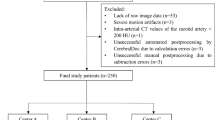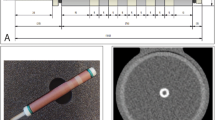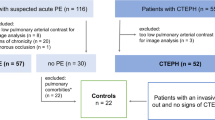Abstract
The purpose of this study was to evaluate the effect of different inversion times (TIs) on flow-sensitive alternating inversion recovery (FAIR) perfusion imaging and compare them with the cerebral blood flow reserve evaluated by acetazolamide challenge using single-photon-emission computed tomography (SPECT). The subjects were nine patients with unilateral obstruction of the internal carotid artery. The signal ratio (SR16/8) of two images with different TIs (1,600 ms and 800 ms) was calculated, and the cerebral blood flow reserve (CFR) was evaluated by the increase in the ratio of cerebral perfusion after administration of acetazolamide in the SPECT study. A reversed linear correlation ( r =0.75) was found between SR and CFR, indicating that differences of FAIR images with changes of TI will be affected by cerebral flow reserve.




Similar content being viewed by others
References
Kim SG, Tsekos NV (1997) Perfusion imaging by a flow-sensitive alternating inversion recovery (FAIR) technique: application to functional brain imaging. Magn Reson Med 37:425–435
Wong EC, Buxton RB, Frank LR (1997) Implementation of quantitative perfusion imaging techniques for functional brain mapping using pulsed arterial spin labeling. NMR Biomed 10:237–249
Uno M, Harada M, Yoneda K, Matsubara S, Satoh K, Nagahiro S (2002) Can diffusion- and perfusion-weighted magnetic resonance imaging evaluate the efficacy of acute thrombolysis in patients with internal carotid artery or middle cerebral artery occlusion? Neurosurgery 50:28–35
Yoneda K, Harada M, Morita N, Nishitani H, Uno M, Matsuda T (2003) Comparison of FAIR technique with different inversion times and post contrast dynamic perfusion MRI in chronic occlusive cerebrovascular disease. Magn Reson Imaging 21:701–705
Yang Y, Frank JA, Hou L, Ye F, McLaughlin AC, Duyn JH (1998) Multislice imaging of quantitative cerebral perfusion with pulsed arterial spin labeling. Magn Reson Med 39:825–832
Edelman RR, Siewert B, Darby DG, Thangaraj V, Nobre AC, Mesulam MM, Warach S (1994) Quantitative mapping of cerebral blood flow and functional localization with echo planar MR imaging and signal targeting with alternating radio frequency. Radiology 192:513–520
Kim SG, Tsekos NV, Ashe J (1997) Multi-slice perfusion-based functional MRI using the FAIR technique: Comparison of CBF and BOLD effects. NMR Biomed 10:191–196
Ogasawara K, Ito H, Sasoh M, Okuguchi T, Kobayashi M, Yukawa H, Terasaki K, Ogawa A (2003) Quantitative measurement of regional cerebrovascular reactivity to acetazolamide using123I-isopropyl-p-iodoamphetamine autoradiography with SPECT: validation study using H2 15O with PET. J Nucl Med 44:520–525
Detre JA, Leigh JS, Williams DS, Koretsky AP (1992) Perfusion imaging. Magn Reson Med 23:37–45
Kuhl DE, Barrio JR, Huang SC, Selin C, Ackermann RF, Lear JL, Wu JL, Lin TH, Phelps ME (1982) Quantifying local cerebral blood flow by N-isopropyl-p-[123I]iodoamphetamine (IMP) tomography. J Nucl Med 23:196–203
Laloux P, Richelle F, Meurice H, De Coster P (1995) Cerebral blood flow and perfusion reserve capacity in hemodynamic carotid transient ischemic attacks due to innominate artery stenosis. J Nucl Med 36:1268–1271
Masdeu JC, Brass LM (1995) SPECT imaging of stroke. J Neuroimaging 5 Suppl 1:S14–22
Palombo D, Porta C, Peinetti F, Brustia P, Udini M, Antico A, Cantalup D, Varetto T (1994) Cerebral reserve and indications for shunting in carotid surgery. Cardiovascu Surg 2:32–36
Arbab AS, Aoki S, Toyama K, Miyazawa N, Kumagai H, Umeda T, Arai T, Araki T, Kabasawa H, Takahashi Y (2002) Quantitative measurement of regional cerebral blood flow with flow-sensitive alternating inversion recovery imaging: Comparison with [Iodine 123]-iodoamphetamin single photon emission CT. AJNR Am J Neuroradiol 23:381–388
Liu HL, Kochunov P, Hou J, Pu Y, Mahankali S, Feng CM, Yee SH, Wan YL, Fox PT, Gao JH (2002) Perfusion-weighted imaging of interictal hypoperfusion in temporal lobe epilepsy using FAIR-HASTE: comparison with H2 15O PET measurement. Magn Reson Med 16:137–146
Hunsche S, Sauner D, Schreiber WG, Oelkers P, Stoeter P (2002) FAIR and dynamic susceptibility contrast-enhanced perfusion imaging in healthy subjects and stroke patients. J Magn Reson Imaging 16:137–146
Weber MA, Gunther M, Lichy MP, Delorme S, Bongers A, Thilmann C, Essig M, Zuna I, Schad LR, Debus J, Schlemmer HP (2003) Comparison of arterial spin-labeling techniques and dynamic susceptibility-weighted contrast-enhanced MRI in perfusion imaging of normal brain tissue. Invest Radiol 38:712–718
Author information
Authors and Affiliations
Corresponding author
Rights and permissions
About this article
Cite this article
Harada, M., Uno, M., Yoneda, K. et al. Correlation between flow-sensitive alternating inversion recovery perfusion imaging with different inversion times and cerebral flow reserve evaluated by single-photon-emission computed tomography. Neuroradiology 46, 649–654 (2004). https://doi.org/10.1007/s00234-004-1228-9
Received:
Accepted:
Published:
Issue Date:
DOI: https://doi.org/10.1007/s00234-004-1228-9




